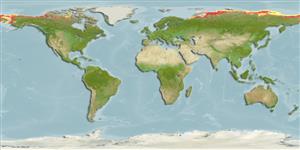分類 / Names
共通名の | 類義語 | Catalog of Fishes(部類, 種) | ITIS | CoL | WoRMS | Cloffa
>
Salmoniformes (Salmons) >
Salmonidae (Salmonids) > Coregoninae
Etymology: Coregonus: Greek, kore = pupils of the eye + Greek, gonia = angle (Ref. 45335); sardinella: sardinella meaning small sardine (Ref. 1998).
More on author: Valenciennes.
Environment: milieu / climate zone / depth range / distribution range
生態学
海; 新鮮な水; 汽水性の; 昇流魚 (Ref. 51243). Polar; 78°N - 62°N, 45°E - 95°W
North America: Murchison River, Canada to Bristol Bay, Alaska; ascends Yukon River to British Columbia, and Mackenzie River to Fort Simpson (Ref. 5723). Asia: Bering Sea, Chukot land and Kolyma River to Kara River on the northern end of the Urals (Ref. 593). Lakes and lower course of large rivers of Arctic Ocean basin from Pechora drainage to eastern Siberia (Ref. 59043). Belongs to Coregonus artedi complex. Occasionally hybridizes with Coregonus nelsoni (Ref. 27547).
サイズ / 重さ / 年齢
Maturity: Lm ? range ? - ? cm
Max length : 47.0 cm TL オス/雌雄の選別がない; (Ref. 5723); common length : 23.0 cm TL オス/雌雄の選別がない; (Ref. 1998); 最大公表体重: 555.00 g (Ref. 593); 最大記録サイズ: 26 年 (Ref. 1998)
背面の脊椎 (合計): 0; 背鰭 (合計): 12-14; 肛門の骨 0; 臀鰭: 10 - 13; 脊つい: 58 - 64. Body elongate, somewhat compressed laterally, greatest body depth at front of dorsal fin. Head about 19 - 24 % of total length; eyes large; snout length usually less than eye diameter; mouth moderate, terminal, lower jaw always protruding, maxillary at a distinct angle, extending posteriorly to below anterior half of the eye; a small cluster of teeth present on the tongue. Overall coloration silvery, usually brown to dark green on the back, becoming silvery on sides and below. The small non-anadromous form that remains in fresh water is without spotting on the back and only the pelvic fins have black pigment on the tips., the remaining fins are unpigmented. The larger, anadromous form has dark spots on the head, back, dorsal, and adipose fins, and sometimes, on the pectoral fins; all fins have usually dark pigment on the tips.
Adults occur in coastal waters, estuaries, large lakes and rivers (Ref. 5723). Lake-dwelling populations appear to be non-migratory, while those found in streams or brackish water move considerable distances to reach or leave spawning sites (Ref. 27547). Semi-anadromous populations forage in estuaries, lower courses of rivers, backwaters and lakes (Ref. 59043). Nerito-pelagic (Ref. 58426). Feed on planktonic crustaceans and insects (Ref. 1998); also plant material (Ref. 27547) and fishes (Ref. 58426). Do not usually feed during its spawning run (Ref. 28219, 28860, 28861). Migratory forms are observed to live longer than fresh water forms (Ref. 1998). Spawn in deep pools on sand and gravel (Ref. 59043). Flesh is said to be tasty (Ref. 1998).
Life cycle and mating behavior
成熟 | 繁殖 | 放精 | 卵 | 生産力 | 幼生
Spawning occurs at night, peaking between 8 pm and midnight. A female spawns almost vertically upward, with her ventral side upstream. She is joined by as many as five males who swim vertically and close to her. As the spawners approach the surface, eggs and milt are released. The fish break the surface, fall over backward, and swim back to the bottom of the pool (Ref. 27547).
Page, L.M. and B.M. Burr, 1991. A field guide to freshwater fishes of North America north of Mexico. Houghton Mifflin Company, Boston. 432 p. (Ref. 5723)
Human uses
水産業: 商業; ゲームフィッシュ: はい
より多くの情報
参考文献水産養殖水産養殖の紹介緊張遺伝子のElectrophoreses遺伝病気行列NutrientsMass conversion
協力者画像Stamps, Coins Misc.音シガテラ(食中毒の名前)速度泳ぐ 型式カマOtoliths脳視覚
用具
特記事項
XMLをダウンロードして下さい
インターネットの情報源
Estimates based on models
Preferred temperature (Ref.
123201): -1.8 - 2.7, mean -0.8 °C (based on 1616 cells).
Phylogenetic diversity index (Ref.
82804): PD
50 = 0.5000 [Uniqueness, from 0.5 = low to 2.0 = high].
Bayesian length-weight: a=0.00437 (0.00373 - 0.00511), b=3.21 (3.17 - 3.25), in cm total length, based on LWR estimates for this species (Ref.
93245).
栄養段階 (Ref.
69278): 3.2 ±0.2 se; based on diet studies.
回復力 (Ref.
120179): 手段, 1.4年~4.4年の倍増期間の最小個体群 (K=0.40; tm=2-4; tmax=11; Fec=2,500).
Prior r = 0.51, 95% CL = 0.34 - 0.76, Based on 2 stock assessments.
Fishing Vulnerability (Ref.
59153): Moderate to high vulnerability (52 of 100).
Nutrients (Ref.
124155): Calcium = 20.4 [9.1, 37.8] mg/100g; Iron = 0.52 [0.25, 0.99] mg/100g; Protein = 18.1 [16.9, 19.3] %; Omega3 = 0.696 [0.272, 1.918] g/100g; Selenium = 11.1 [4.1, 30.5] μg/100g; VitaminA = 6.92 [1.15, 41.73] μg/100g; Zinc = 0.521 [0.395, 0.737] mg/100g (wet weight);
